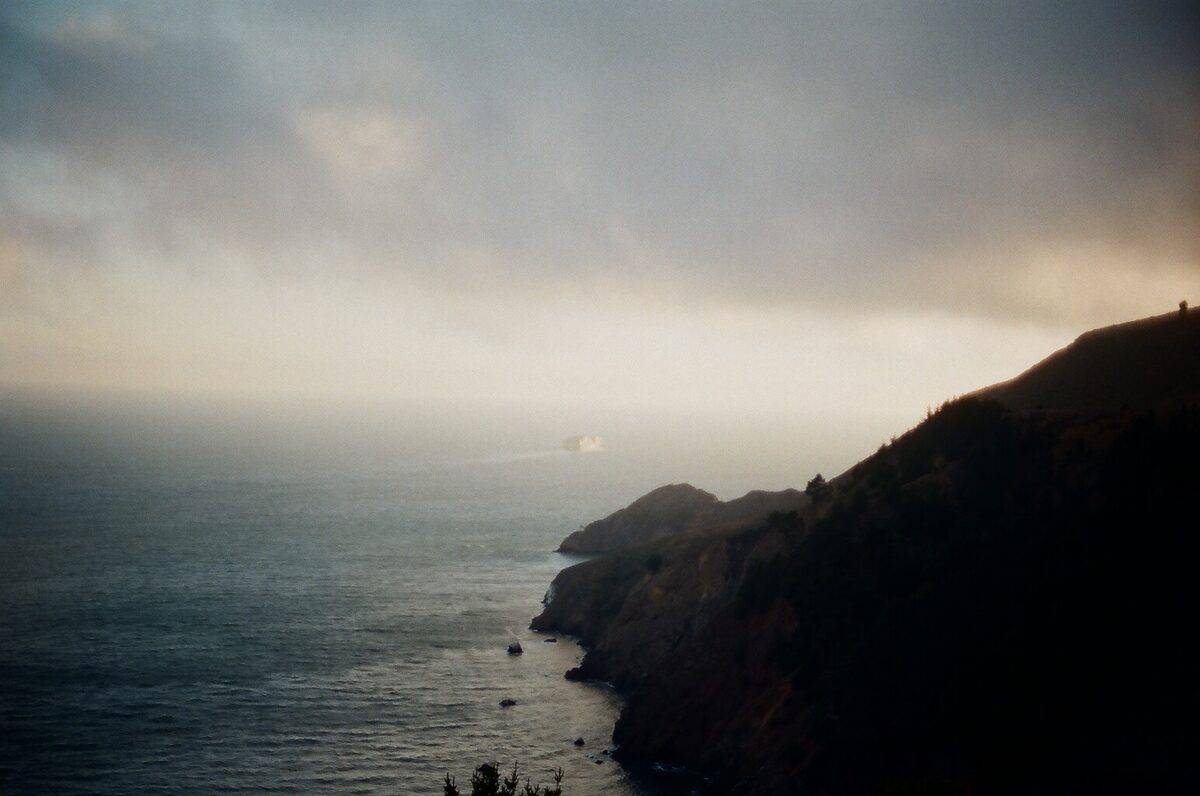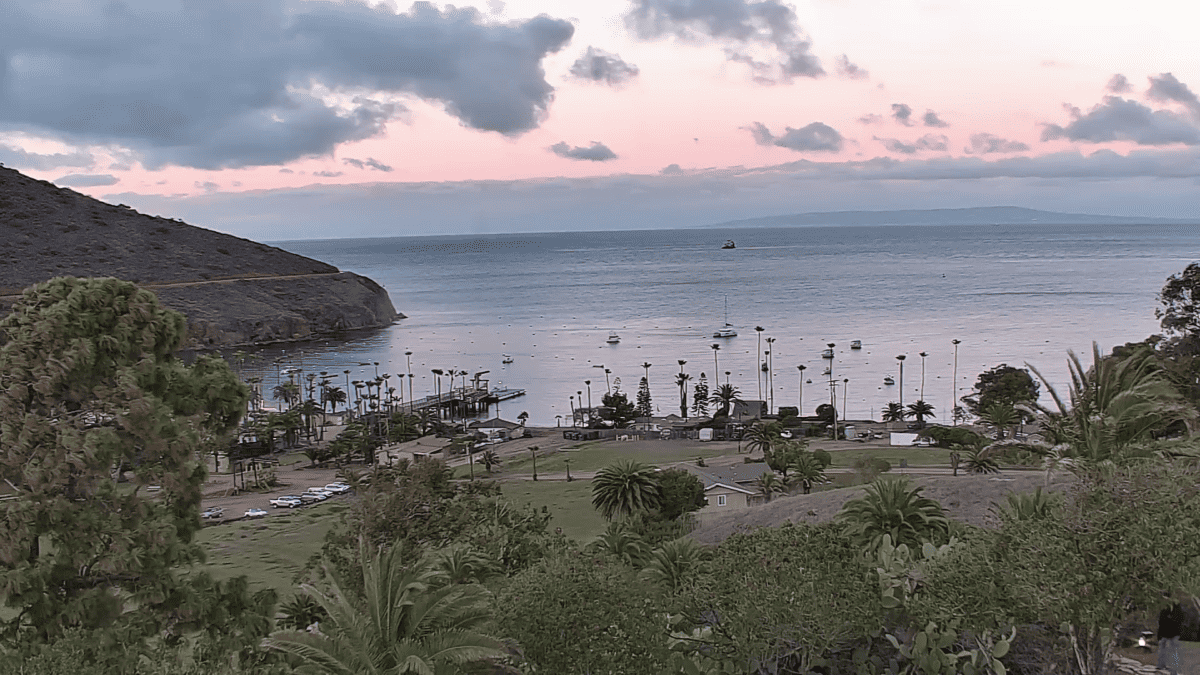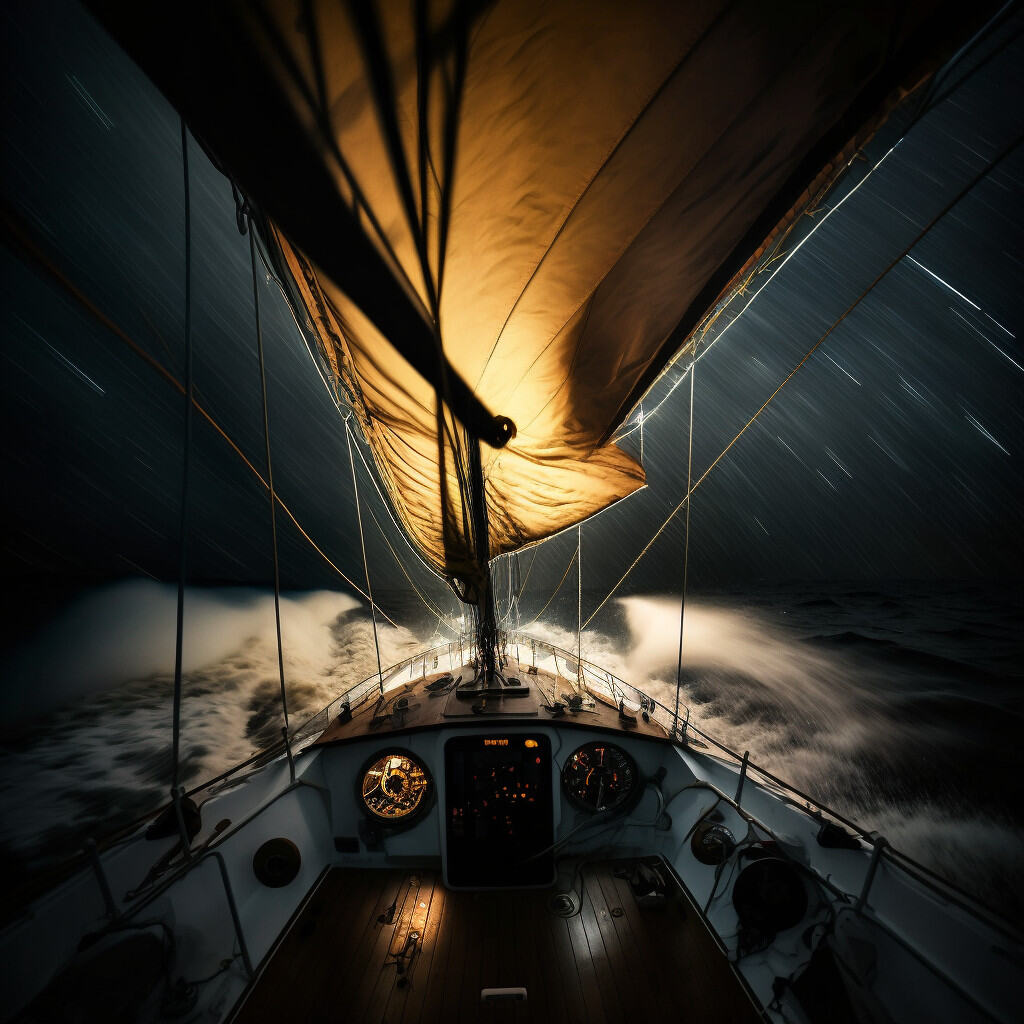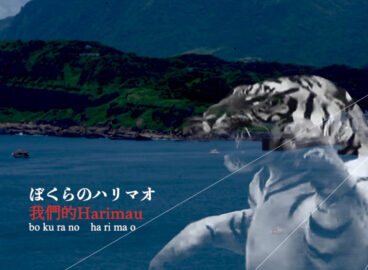What happens when we cross over to the other side? In relation to the phenomenon of transshipment – the risky and at times illicit practice of transferring cargo from one ship to another – artist and poet Rindon Johnson ruminates on borders and bodies that remain in flux.

[A hazy image shows a distant container ship at dusk, with the strong mountain range of the Marin Headlands stretching into the sea on the right. The sky is a gradient of grays, pinks, and white.]
Canon AE-1, Marin Headlands, 2007. All images courtesy Rindon Johnson
I spent my childhood in the hills or in the sea. I liked to listen to the fog. I ran cross-country, I ran through the woods, the grass, and the meadows; I ran all the time, so much I wore out my knees and now my knees ache at random. When my friends and I got our licenses, we often went to the Marin Headlands. By the time we got to it, the Headlands was a national park; it still is. First though, it was Coast Miwok lands. All of California is unceded. Later, the area was home to Portuguese and Spanish dairy farmers, and marked by all the violence of their arrival. Since the 1900s, it has been a federal military base, which swelled into a monster of an outpost in the 1940s to protect Americans from the perceived threat from the other side of the Pacific. Nobody came. Nevertheless, it was deemed appropriate to intern our own citizens and residents.1“Historical Stories in the Marin Headlands,” National Parks Service website, https://www.nps.gov/goga/learn/historyculture/marin-headlands-historical-stories.htm#:~:text=The%20Marin%20Headlands%2C%20with%20its,covered%20with%20prosperous%20dairy%20farms. I remember mulling over this violence when I was still young: Why did that happen like that? It is funny to remember that sense of confusion, despite not knowing or having any of the knowledge then that I do now about the trinity of imperialism, racism, and colonization. Though it was nameless then, I still felt the ambient, unflinching whine of the accumulation of capital, among its cacophonous cohort of atrocities.
There are two ways to get to the Headlands. The way the tourists go, which involves traffic on the weekends and an incredible drop straight to the ocean. Or the way you go when you’ve seen the Golden Gate Bridge before: through a five-minute-long one-way tunnel that spits you out into a valley surrounded by gentle hills, rambling to the sea. Winding through and around and then down a little (if you drive fast, you can make your stomach flip), the beach unveils itself, a lagoon, a parking lot, the cliffs, dark sand; there’s a particular vibrancy and depth to the blue of the Headlands; everything is shrouded with it, the dark swirling, freezing ocean. The sand is so fine and on some days nearly black. The surf in its verticality is so strong, there is kind of a steepness imprinted in the sand, not quite an embankment, a steep slip to the ocean. Meters-high rocks, scale, scale, scale, wind, brush, sage, rumors of a helicopter landing for unknown reasons, and then back in the hills, which were filled with bunkers, deep, crazy caverns, cracking and dripping. I’ve never seen anything darker, filled with people, at least we wagered, kids from other high schools had tall tales buoyed by the traces; lots of jokes are based in fear, writing our names timidly near the entrances, never going much deeper. Rin was here.
Years later, on the street in the rain, Mad told me I was reserved, not quiet. I realized later walking home how I emulated the landscape of my childhood. I think of the darkness of the bunkers and the fog meandering across that big expanse of whatever you call gray when it’s blue, the city across the way and then the bowing horizon, and always a ship going out to the Pacific. Sometimes, I notice things really quickly, and other times, I’m so busy living inside of one thing, I don’t realize the illusion of the other. Like how those ships are so large, the city seemed closer than it was. What was in those containers? It did not matter then, we found the boat a kind of metronome. We’d be sure to see it, smoking somebody’s brother’s California medical marijuana out of an apple on that federal territory before going back to our cars to giggle, or if I was with a lover,2Does this mean the same thing when you are a teenager? to touch each other until the sun was long gone and the great white lights of the federal police told us from their loud speakers to go home.

[A dark color film photograph depicts a bunker with about an inch of water on the ground and an open doorway near the right-hand side of the bunker; there is graffiti on the door jamb and walls of the doorway.]
Canon AE-1, Marin Headlands, 2007

[View looking down into a dirty waterlogged doorway with trash of soda cans, paper, plastic bottles, old bags of chips, and unidentifiable brown and black dirt and refuse. On the left of the image is a concrete step going upward. The walls of the formerly white space are dirty with moss and graffiti.]
Canon AE-1, Marin Headlands, 2007
In a cafe, as a lark, I suggest to X—a curator who has invited me to do an exhibition in Shanghai—that I would like to cross the Pacific Ocean. I base this lark on the fact that yes, I will always be tied to the Atlantic for the accident of birth.3I am black; there are only so many ways that ambiguous blackness could have arrived. However, in practicality, I feel far more tied to the Pacific, having grown up in it, around it, having visited family who had transplanted themselves to Hawai’i, and always, always swimming in it, even now, by chance, marrying a woman from the other side of it. That to cross the Pacific on the various highways of winds that flow across might provide an interesting exercise, one that might not be possible in the future. There were also things that made this act of crossing an American one, more specifically a colonial one. Obvious question: How much has my country irrevocably changed the nations of the Pacific? Besides that there was something about the fact that it matters how you get somewhere, and more in there too that I wasn’t quite sure about all of it; what is the point of this?4What isn’t the point of this? It was something, though. In short, I talk myself into a knot and then look up at X. They smile, they think that’s the best idea I’ve presented and that I should indeed cross the Pacific. The Pacific grows in their mind too; it zigzags or maybe bogs up beside us both. So, I will cross. My next preoccupation: how?
Likely the last time I sailed was at age 13 off the coast of Pimu (Catalina Island). In the water I was focused, sharklike. I won my races; I got the gold star in sailing. The only phrase that has really stuck with me after these 20 years is “tacking into the wind,” that to go forward you’d have to do a dance in triangles to arrive at your destination, never being pushed backward, but never straight forward exactly either. This is around the time I think if I had been born a bit later, I would have come out as trans; I didn’t know what to call it then, even with trans adults floating near me in San Francisco. I was too afraid of them. On the water and in it, the changing of my form and its congruous incongruencies with myself were held at a remove. The sheltered bays of Pimu are not the open waters of the Pacific.

[View from two harbors isthmus toward Los Angeles. The bottom of the image is rimmed by palm trees; there are a few boats bobbing in the ocean, which is relatively calm and reflects the partly cloudy morning sky of pinks and grays.]
Live Stream, 2022
I settle on some sort of 40- to 50-foot boat, which I will rent or buy. I learn I’ll need to leave between January and April, and if I don’t stop, it will take me around 30 to 40 days, depending on how things go with the weather. I won’t go alone. I’ll need some companions. I search for them. Likely, we will go in a regatta, with some others who are crossing. This is safest. I begin to compile the tools I’ll need to properly sail. I spend hours on the internet, researching alone and chatting excessively with ChatGPT. I learn that, in addition to my boat and the various rations, I will need the following in both analog and digital forms:
- A compass
- GPS
- Charts and maps
- SSB radio and VHF radio
- Weather-forecasting tools
- GPS-enabled sextant
- A logbook
- Automatic identification system (AIS).
Each tool is familiar to me except for the Automatic Identification System (AIS). AIS is used for automatic tracking of large ships and passenger boats. It allows the operator of the vessel to receive and transmit information, such as the ship’s name, position, course, and speed, to other AIS-equipped vessels and shoreside traffic-control centers. Essentially, it transmits who you are to everybody and transmits who everybody says they are to you too. On the water, they say, see and be seen.5Ken Englert, “How to Use AIS: Using AIS as a safety tool,” United States Coast Guard Boating Safety website, October 23, 2012, https://www.boatingsafetymag.com/safety-tips/how-use-ais/. Or that’s how it’s meant to be.
I increase my watching of sailing videos on YouTube, I focus on crossing. I watch other people cross in 15-20-30-60-minute bursts, families, solos, couples. I watch their tensions, boredom, the horizons, the fish they catch, their bodies writhing in pain, flipping, the humans grinning holding that transparent line, the flat eye of the fish narrowing in exhaustion,6“How We Fish While Sailing—Travel Tips // Sail Our World,” Sail Our World, April 7, 2020, YouTube video, 9:56, https://youtu.be/-jsuUsP-Boo. intermingled as if imbibed with hot sauce into the human, exhausted in the late hours, the sudden squalls, the choppy waves. I watch them stare at their digital charts, their compasses, and their AIS.
Every group I watch eventually struggles with readings on their devices and often on their AIS. Either there are ships that are spoofing—pretending to be larger or smaller than they actually are—or there are ships that have turned off their AIS altogether.
On their voyage to Uruguay, sailing couple Kate and Curtis of the YouTube channel Sailing Sweet Ruca, chronicle their run-in with an illegal fishing vessel.7“Incredible & Dangerous Encounter While Sailing Offshore—[Ep. 92],” Sailing Sweet Ruca, November 20, 2022, YouTube video, 25:34, https://www.youtube.com/watch?v=FihQZepmB-w&list=PLu2Y7j55_nR9qCo_ndnKJ0QicUmlQpfSq&index=6. Accessed 1 Apr. 2023. The episode begins, as most sailing vlogs do, with a teaser of the big event and then jumps right into their day-to-day. They explain how their dog, Roxy, uses the restroom on board the sailboat,8For those of you wondering, she goes to the front deck and does her business into what looks like a Tupperware container. The view is nice, but I do wonder how it must feel to be a dog on a boat. breakfast is made, routes are planned, a day passes, things are fixed, wind is scarce until it isn’t. On the third night of their voyage, during heavy winds—and all the efforts it takes to move through those—the radar alarm9“Incredible & Dangerous Encounter While Sailing Offshore,” 19:19–25.34. goes off and they discover that there is something very close to them. Kate identifies it as a fishing boat, and it is less than a mile away. The drama of this moment is narrated and explained more than felt in a traditional dramatic sense. Visually, to a non-sailor; the moment feels somehow confusingly mellow. The fishing boat looks far away, just a white light splitting the darkness into horizon and sky. The stress level in Kate’s voice drives home a truism of sailing: distance on the water is very different from distance on land.
“Curtis has been battling him for at least the last half hour,” Kate explains. “He keeps changing direction every time we change direction, making a collision course with us, so finally we had to turn on the motor . . . and just try to get by him.” They try to radio the fishing boat, but there is no response. Kate turns the camera to reveal their view, the main sail, the ropes flexing, sailing in the dark, into nothingness, tool-dependent, tipped to the right, the wind is fast at 20 knots, there is spray coming over the bow, it’s wet.10The “bow” is term used to mean the front of the boat, or the most forward part of the hull. “What the **** is this guy,” Curtis says in calm frustration. He’s spotted another boat on the AIS and asks Kate to go down and take a closer look. It is a 91-foot fishing vessel going 3.5 knots. The boat’s AIS popped on and then off again, suddenly. While it is common enough for boats not to always leave their AIS on, in this circumstance, it is odd; in this weather, at night, usually you’d be in communication via radio with the other vessel, doing what you can to avoid one another. So now there are two boats. One directly behind the other. And suddenly, they’re closer. Still no response on the radio, the spray continues. Frustrated, Kate says, “We all have to respect each other, but I don’t know what this is, it’s just carelessness.” At this point, Kate and Curtis are going upwind using their motor and doing everything they can to avoid this second boat, which reads a mile away from them. It continues, their radar isn’t picking up the second boat’s location, and now Kate and Curtis must depend on their vision alone to figure out how to avoid them. They can see their lights and that’s it; they can’t tell which side of the boat they’re seeing, what direction the boat might be taking. These confusions have forced Kate and Curtis to continue to keep their motor on, going straight into waves that are beating their boat down.

[The view toward the bow of an approximately 40-foot sailboat in a storm at night. The only lights come from the control panel and from the mast of the sailboat at the center of the image; at the bow of the boat, there are fast moving waves and then darkness.]
Constructed Image from Midjourney, 2023
Unbelievably, Curtis spots another vessel. Kate takes a look, “It’s almost like it’s two different AISs for the same vessel.” Curtis agrees, “He’s got a fake-out AIS. These guys are probably all illegal.” Kate gives us a further description: One AIS went off, another went on, they’re in the same position according to the charts. They’re spoofing. “God, it shows him pointing directly at us too, like he wants to hit us.” Kate and Curtis have all their lights on, they want to be visible, they are not trying to hide, they’re just trying to get through. Kate predicts that this will be a sleepless night for her and Curtis; the wind picks up. A week later, Curtis and Kate will find out that the Uruguayan navy caught a Chinese fishing vessel in the same location they had been sailing in.11Chris Dalby, “Squid Game—Uruguay Navy Chases and Captures Chinese Fishing Vessel,” InSight Crime, July 6, 2022, https://insightcrime.org/news/squid-game-uruguay-navy-chases-and-captures-chinese-fishing-vessel/. Kate notes in her final narration that she and Curtis cannot say for sure if these boats were illegally fishing or not, but given their behavior, it seems quite possible.
The Uruguayan navy put footage of the capture of the fishing vessel on YouTube. The whining of a helicopter provides a heavy soundtrack as the large blue-hulled fishing vessel bobs in the water alongside the navy ship.12“Uruguayan Navy Arrests Chinese Jigger which Tried to Flee Arrest,” MercoPress, July 5, 2022, YouTube video, 0.42, https://www.youtube.com/watch?v=sOqwxsbkA-M&t=1s. See also, “Uruguayan Navy arrests Chinese jigger which tried to flee arrest, MercoPress July 5, 2022, https://en.mercopress.com/2022/07/05/uruguayan-navy-arrests-chinese-jigger-which-tried-to-flee-arrest. In another shot, two dinghies surround the fishing vessel. This dance from my view, the computer, seems static, like a painting; the charge is the matter.
Likely, when a boat does not come up on an AIS, that boat’s main job is to transship. I am trans, we must be related. (I’ve told this joke before.)
“Transshipment” is a term used to describe the transferring of cargo from one mode of transportation to another during its transit from point of origin to final destination. For example, this could mean transferring cargo from a ship to a train, or from one ship to another ship. In the Pacific Ocean, transshipment has a long history that isn’t worth relaying here. We can speculate that transshipment likely hit some sort of uptick with the opening of the Panama Canal in 1914.13Encyclopædia Britannica online, s.v. “Panama Canal,” https://www.britannica.com/topic/Panama-Canal. And that uptick at the Panama Canal then grew exponentially with the growth of the globalizing economy in the 1990s.14Jean-Paul Rodrigue and Theo Nottebook, “The Legacy and Future of the Panama Canal: From Point of Transit to Transshipment Hub,” ResearchGate, January 15, 2015, https://www.researchgate.net/profile/Jean-Paul-Rodrigue/publication/297860756_The_legacy_and_future_of_the_panama_canal_From_point_of_transit_to_transshipment_hub/links/59dfb17b458515371600cc6f/The-legacy-and-future-of-the-panama-canal-From-point-of-transit-to-transshipment-hub.pdf. In its innocent form, transshipment is used to optimize logistics and save on transportation costs. However, as obvious as this is to state, transshipment can also be used to bypass bottlenecks or trade barriers.
Illegal transshipment can take many forms: smuggling, tax evasion, fraud. Transshipment is resorted to in order to avoid tariffs and quotas. To further avoid inspection, goods are mislabeled, paperwork is falsified, and certain circuitous shipping routes are taken. Transshipment can be used to smuggle goods like drugs and weapons, or live beings like rare wildlife and nolonger-living beings like fish and other dead sea creatures. These activities all live under the title of illegal, unreported, and unregulated (IUU). IUU fishing vessels will engage in transshipment at sea, where the fish is caught by one vessel and then transferred to another (and sometimes even another) to then be brought to market.
To accomplish the first part of this IUU fishing, a ship will turn off their AIS to conceal their identity and location, or at the very least, confusing or, for lack of a better word, troubling it. This process of concealment is known as “dark shipping,” and it is this practice that Kate and Curtis found themselves caught in the middle of.

[Two large boats on the open ocean at midday under a cloudless sky face in opposite directions.]
Constructed Image, 2023
In Hakai Magazine’s article “Catch Me If You Can: The Global Pursuit of a Fugitive Ship,” writer Sarah Toy details the complex and intense process of catching the IUU fishing vessel STS-50 in 2018. The capture involved multiple governments and agencies all working together in tandem, often the effort coming down to one email or phone call. Before the vessel was caught, it operated for eight years under different names, with crew members coming and going, some knowing the legality of the ship’s activities, and others just passing through. STS-50, like many other IUU ships, sold its catch to many different middlemen.
As investigators began to close in on STS-50, Toy narrates:
“STS-50 tried to evade tracking by periodically switching off its AIS and using a generic Maritime Mobile Service Identity (MMSI) number, a nine-digit code that is supposed to be unique to each vessel. With the generic identification number, the STS-50 was able to hide under other ships’ transmission signals, says Bergh, “a bit like everybody trying to talk on the same frequency on a radio.” Specialists at Trygg Mat Tracking (TMT), a Norwegian nonprofit that provides vessel tracking analysis to FISH-i Africa, were able to decipher the STS-50’s intermittent satellite signals and detect where the vessel really was. It was like playing a game of cat and mouse in an area larger than the Australian continent.”
STS-50 fled toward Indonesia, a nation whose task force to combat illegal fishing had blown up more than 400 illegal fishing boats since 2014. Since STS-50 only occasionally turned on its AIS, trackers found themselves predicting the ship’s location between each ping, assuming its course. Eventually it pinged in, likely to let the owner of the ship know its location, and the Indonesian navy was able to intercept it. The captain was fined and put in prison, but the owners cannot be prosecuted. “On the high seas, the bad guys have almost always gotten away—a frustrating reality of the seemingly Sisyphean task of policing lawbreakers in such a vast arena.”15Sarah Toy, “Catch Me If You Can: The Global Pursuit of a Fugitive Ship.” Hakai Magazine, March 3, 2020, https://hakaimagazine.com/features/catch-me-if-you-can/.
A vast arena, liquid and thus confusing, it can hold me yet—shipping, illegal fishing—whole ecosystems and beings we’ve never met and probably never will. Paradoxically, once something is nameable, it can be contained. Maybe it’s better to play the homophone and hear that it’s a parallax. The incongruities of trying to make an image when the lens is actually lower than where your eye composes the picture. Transshipment—in its evasion of being known by continuing to go across—sounds familiar. In the case of the shipment, an exploited group of beings taken and going from one state to the next.
What is a definition but an act mired in its traces? We know that transshipment is happening because we see the boats, the boats are caught, the fish are gone, but are we literally seeing the fish brought up onto the decks? Not often. Fragmentation by way of commodification. Confusingly, we have a lot in common—that is me, the act of transshipping, and the very things that are being transshipped. We are reliant on others to exist on multiple levels. We are full of legal and illegal missions and substrates. In IUU transshipment, there is the plundering of the oceans, and in transness, there is a liberation for the person bearing the label.
The self is a troubling political object. Its maintenance is a pawn to be trifled with, exchanged for a different person’s will, whether that is being in the world or what one ingests in order to live. Containment means not just the possibility to be incorporated into capital accumulation but the possibility to be obliterated because of lack of access to things that are basic to one’s survival. My lines of logic have me running toward myself as a commodity. Is that what I share with the shipment? Commodities are to be traded. I won’t be going to Tennessee or Kentucky any time soon. What does the marine life say? Let’s all trade places in this merry-go-round of exploitation.
Vexing statement: Trans is whatever the group needs it to be. In certain instances, nobody needs it to be much of anything; in others, it is the very structure upon which the entire artifice of social interaction is built; and still in others, it is the perfect scapegoat for the uncomfortable god-level truth, change. Trans is the demon, the liberator, the cocoon, the bear, the cave, the ship, the fisherman, the sailor, and me.
There is a phenomenon called “group random dance.” What happens is groups of people get together and play clips of K-pop songs, and if you know the dance, you go to the center and do it. These groups are large, young, queer, trans. Their vibe is good, diverse; there is an air of excitement, encouragement. They are showing off together. These random dances happen all over the world and are very popular. My five-year-old daughter and I watch these random dances while we draw in my studio. In one random dance in Frankfurt, we stop drawing for a long time to witness this group energy. As is custom, each clip is followed by a computerized voice counting down to the next clip, 5, 4, 3, 2 . . . There’s a collective pause as each song comes on; usually there’s a few squeals, a shout, a scream, and then always a mad dash for the center. Places! Then my daughter and I wait for the moment when they all, together, really do perfectly sync up. A lift of a leg, a hip pop, a head shake, a raised hand in a circular motion.
We also watch for a phenomenon we haven’t fully named yet, something like the confusion of the mirror. What happens is that some of the people dancing know the dance from one perspective, and others know the dance from another. So that means they’re doing the same moves, but one is going right while the other goes left. Elbows knock and concentrations are broken.16“[PUBLIC] KPOP RANDOM PLAY DANCE in Frankfurt, Germany | 케이팝 랜덤 플레이 댄스 | JULY 2022.” K-FUSION ENTERTAINMENT,” August 27, 2022, YouTube video, 51.20, https://www.youtube.com/watch?v=YxZvrBpCfNc. Implied in these public random dances is that they all kind of know what’s going on, not enough to be the “real” thing, but they’ll try all together, kind of knowing the dance is enough; the point is to be dancing, to be giving it a go, to all be trying. Or at least that’s the point I’m seeing from it (we can only read so much of another person’s reasoning through the filter of our own logic). Trying is worth it at least.
Night in our corner of Berlin is quiet, mostly just footsteps and the occasional shout, and still I am unable to sleep. I give in, walk myself to my computer, I begin looking for 40-foot sailboats; there’s one in Providence that could be promising. My ears burn when I am afraid but I kind of like the feeling. I imagine myself reading charts at the shining table on this particular vessel. Poring over the lines, the weather. I bid on the boat; it will be my most expensive artistic endeavor. Anything to cross over. I walk to the window to hear the morning birds. I wait.
- 1“Historical Stories in the Marin Headlands,” National Parks Service website, https://www.nps.gov/goga/learn/historyculture/marin-headlands-historical-stories.htm#:~:text=The%20Marin%20Headlands%2C%20with%20its,covered%20with%20prosperous%20dairy%20farms.
- 2Does this mean the same thing when you are a teenager?
- 3I am black; there are only so many ways that ambiguous blackness could have arrived.
- 4What isn’t the point of this?
- 5Ken Englert, “How to Use AIS: Using AIS as a safety tool,” United States Coast Guard Boating Safety website, October 23, 2012, https://www.boatingsafetymag.com/safety-tips/how-use-ais/.
- 6“How We Fish While Sailing—Travel Tips // Sail Our World,” Sail Our World, April 7, 2020, YouTube video, 9:56, https://youtu.be/-jsuUsP-Boo.
- 7“Incredible & Dangerous Encounter While Sailing Offshore—[Ep. 92],” Sailing Sweet Ruca, November 20, 2022, YouTube video, 25:34, https://www.youtube.com/watch?v=FihQZepmB-w&list=PLu2Y7j55_nR9qCo_ndnKJ0QicUmlQpfSq&index=6. Accessed 1 Apr. 2023.
- 8For those of you wondering, she goes to the front deck and does her business into what looks like a Tupperware container. The view is nice, but I do wonder how it must feel to be a dog on a boat.
- 9“Incredible & Dangerous Encounter While Sailing Offshore,” 19:19–25.34.
- 10The “bow” is term used to mean the front of the boat, or the most forward part of the hull.
- 11Chris Dalby, “Squid Game—Uruguay Navy Chases and Captures Chinese Fishing Vessel,” InSight Crime, July 6, 2022, https://insightcrime.org/news/squid-game-uruguay-navy-chases-and-captures-chinese-fishing-vessel/.
- 12“Uruguayan Navy Arrests Chinese Jigger which Tried to Flee Arrest,” MercoPress, July 5, 2022, YouTube video, 0.42, https://www.youtube.com/watch?v=sOqwxsbkA-M&t=1s. See also, “Uruguayan Navy arrests Chinese jigger which tried to flee arrest, MercoPress July 5, 2022, https://en.mercopress.com/2022/07/05/uruguayan-navy-arrests-chinese-jigger-which-tried-to-flee-arrest.
- 13Encyclopædia Britannica online, s.v. “Panama Canal,” https://www.britannica.com/topic/Panama-Canal.
- 14Jean-Paul Rodrigue and Theo Nottebook, “The Legacy and Future of the Panama Canal: From Point of Transit to Transshipment Hub,” ResearchGate, January 15, 2015, https://www.researchgate.net/profile/Jean-Paul-Rodrigue/publication/297860756_The_legacy_and_future_of_the_panama_canal_From_point_of_transit_to_transshipment_hub/links/59dfb17b458515371600cc6f/The-legacy-and-future-of-the-panama-canal-From-point-of-transit-to-transshipment-hub.pdf.
- 15Sarah Toy, “Catch Me If You Can: The Global Pursuit of a Fugitive Ship.” Hakai Magazine, March 3, 2020, https://hakaimagazine.com/features/catch-me-if-you-can/.
- 16“[PUBLIC] KPOP RANDOM PLAY DANCE in Frankfurt, Germany | 케이팝 랜덤 플레이 댄스 | JULY 2022.” K-FUSION ENTERTAINMENT,” August 27, 2022, YouTube video, 51.20, https://www.youtube.com/watch?v=YxZvrBpCfNc.





